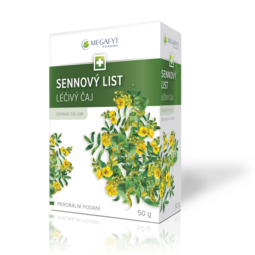Traditional herbal medicinal product
Sennae folium
For oral use
Use
Always take this medicine exactly as described in this leaflet or as your doctor or pharmacist has told you. Check with your doctor or pharmacist if you are not sure.
Short-term treatment of functional constipation.
Ingredients
- Sennae folium (senna leaf) 50 g
Preparation
Pour 0.25 l of boiling water over 1 teaspoon (1 g of senna leaves), leave it to infuse for 15 minutes and then strain it. Tea should be drunk warm once a day, preferably before the bedtime. It is usually sufficient to administer the medicinal product 2-3 times a week.
The infusion is always prepared fresh, immediately before use. The effect occurs in 8 to 12 hours.
Packaging
50 g
Storage
Keep the product out of the reach and sight of children.
Store in a dry place below 25 °C.
Caution
The preparation is only intended for short-term use, no longer than one to two weeks.
Contact your doctor if the health condition does not improve.
Chronic use of ever-increasing doses can lead to addiction (addiction syndrome), which can cause fluid and electrolyte imbalances.
In patients with kidney diseases, administration of the product may cause an imbalance in the level of electrolytes, so consult a doctor about using the tea.
If you are using cardiac glycosides (digoxin), antiarrhythmics (medicines against heart rhythm disorders) (e.g. amiodarone, verapamil, etc.), diuretics (medicines that increase the production and excretion of urine), adrenocorticoids or preparations containing licorice, consult your doctor before using senna leaf.
If you suffer from chronic constipation or other undiagnosed digestive problems (e.g. abdominal pain, nausea, vomiting), consult using the product with your doctor, because these symptoms may be a sign of serious health problems (intestinal obstruction).
Senna leaf should be only used if it is not possible to improve the difficulties by changing lifestyle (change eating habits, i.e. intake of more fiber and fluids; increase in physical activity).
In patients suffering from incontinence (inability to hold stool), it is necessary to change sanitary napkins more often to prevent prolonged skin contact with stool.
During the use of the product, the urine color change (yellow or reddish-brown color, depending on the pH value) may occur, but this is not clinically significant and will disappear spontaneously.
Long-term use can cause pigmentation (coloring) of the intestinal mucosa (pseudomelanosis coli), which usually subsides after discontinuation of the product.
If any unusual reactions occur, stop using of the product and consult a doctor.
It is necessary keeping the medicinal product out of the reach and sight of children. Do not use after the expiration date stated on the package. Return the unused drug back to the pharmacy.
Contraindication
Known hypersensitivity to the medicinal substance.
Intestinal obstruction and/or laxity, diarrheal diseases, sudden abdominal attacks, inflammatory bowel diseases (e.g. Crohn's disease, ulcerative colitis (inflammation of the large intestine accompanied by the formation of ulcers), abdominal pain of unknown origin, loss of fluids and electrolytes.
Children under 12 years, pregnant women and breastfeeding mothers.
Interaction
Long-term use of the product reduces the level of potassium in the blood, which can increase the effect of cardiac glycosides and affect the effect of drugs against heart rhythm disorders, drugs causing sinus rhythm reversal (eg quinidine) and drugs prolonging the QT interval.
Side effects
Very rarely, the product can cause skin reactions (itching, hives, redness of the skin).
The product may cause crampy abdominal pain and watery stools, especially in patients with irritable bowel syndrome. However, these symptoms also occur in overdose. In these cases, it is necessary to reduce the dose.
Chronic use can lead to water and electrolyte imbalances, especially potassium. Chronic use of high doses can cause toxic inflammation of the liver.

 Herbal medicinal products
Herbal medicinal products  Herbal Pharmacy
Herbal Pharmacy Children´s teas
Children´s teas Fruit and other teas
Fruit and other teas Wellbeing
Wellbeing Limited edition
Limited edition

 Facebook
Facebook Instagram
Instagram